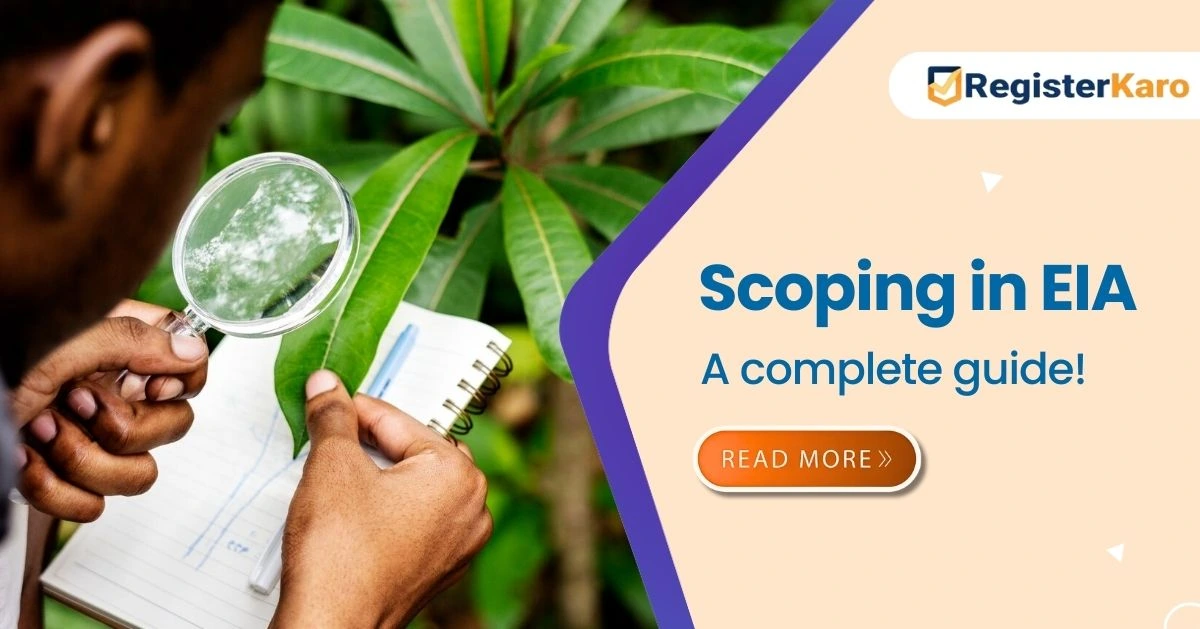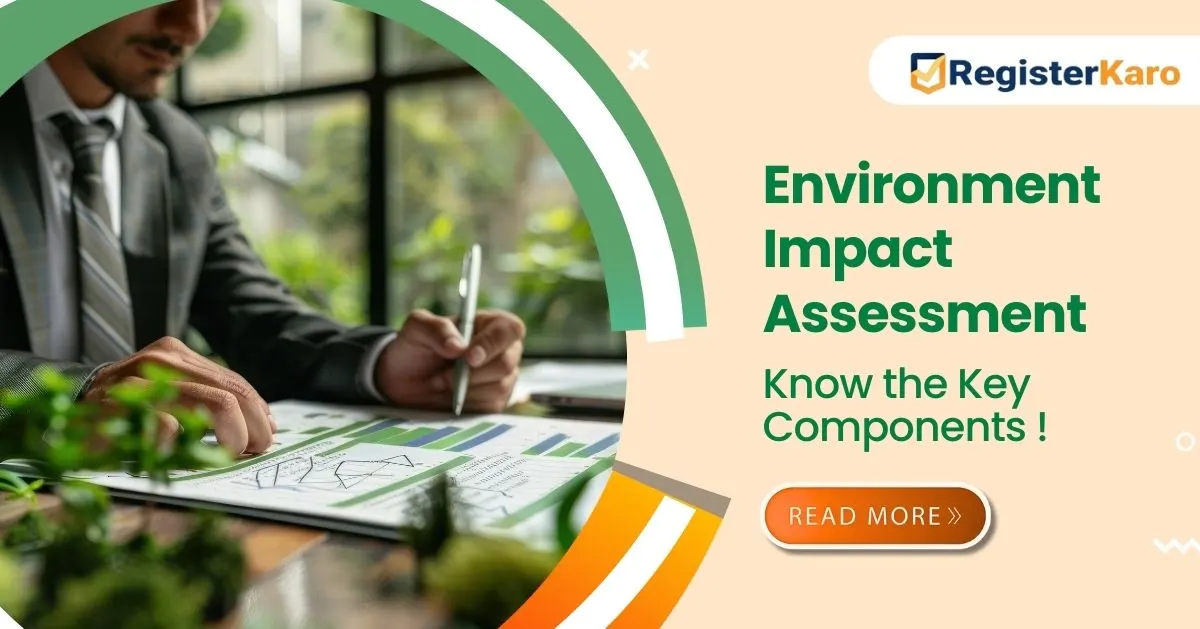
Introduction
If you’re planning a development project in India, you’re likely aware that obtaining environmental clearance is critical to the approval process. One essential step in this journey is conducting an Environmental Impact Assessment (EIA). But how much does the cost of Environmental Impact Assessment add to your project expenses? Understanding the EIA cost is key to planning and budgeting effectively for your project.
This blog will provide you with a detailed breakdown of the cost factors associated with an Environmental Impact Assessment (EIA) in India, the various components involved, and how RegisterKaro can assist you in managing the impact assessment process at an affordable price.
Why is EIA Crucial for Project Approvals in India?
In India, EIA is a mandatory requirement for projects that could significantly impact the environment. Under Indian law, projects must receive environmental clearance before construction or operation can begin. This process not only ensures compliance with regulations but also mitigates long-term environmental damage. Therefore, understanding the EIA cost is essential for any developer looking to obtain the necessary clearance and proceed with their project.
Overview of Cost of Environmental Impact Assessment
The cost of Environmental Impact Assessment varies greatly depending on several factors. These factors can include the size of the project, its complexity, the location, and the type of industry involved. It’s important to budget for both direct and indirect costs that will be incurred throughout the impact assessment process. Let’s break down the primary cost considerations and what you can expect when embarking on an EIA cost in India.
Factors Influencing the Cost of Environmental Impact Assessment
Several factors affect the EIA cost in India. These include:
Project Size and Complexity
The cost of EIA generally increases with the scale and complexity of the project. Larger projects typically require more extensive data collection, additional environmental studies, and more detailed reports, all of which increase costs.
Type of Industry and Sector-Specific Regulations
Different industries have varying EIA requirements. For example, sectors like mining, real estate, or manufacturing may require more comprehensive assessments due to their potential environmental impact. Industry-specific regulations often add additional costs.
Location and Environmental Sensitivity of the Project Site
The location of your project plays a significant role in the EIA cost. Projects located near ecologically sensitive areas like forests, wetlands, or coastal zones may incur higher costs due to the need for more detailed studies and mitigation strategies.
Consultant and Expert Fees
Hiring experts, including environmental consultants, ecologists, and engineers, forms a significant portion of the Environmental Impact Assessment fees. These professionals charge fees based on their expertise, the complexity of the project, and the time required to complete the assessment.
Cost of Baseline Studies and Field Surveys
Baseline studies are essential to assess the existing environmental conditions of the project site. These studies involve field surveys, lab testing, and monitoring, all of which add to the EIA cost.
Public Consultation and Stakeholder Engagement Costs
Public consultation is a mandatory part of the EIA process, and organizing these consultations can incur costs. These include expenses related to hosting public hearings, providing information to stakeholders, and addressing community concerns.
Regulatory and Government Fees for EIA Approval
In addition to consultant fees, developers must pay regulatory Environmental Impact Assessment fees in the application. These fees are set by the MoEF&CC and state authorities and vary depending on the project’s size and type.
Breakdown of Cost of Environmental Impact Assessment
Here’s a closer look at the individual cost of environmental impact assessment involved in the EIA process:
Screening and Scoping Fees
The initial stages of screening and scoping require minimal costs but can increase based on the need for additional environmental reviews in the EIA process cost.
Baseline Data Collection Costs
Collecting baseline data involves conducting surveys on air quality, water bodies, soil health, and biodiversity. The EIA process cost for these studies can vary depending on the complexity and location of the project.
Impact Prediction and Mitigation Planning Expenses
Predicting potential environmental impacts and planning mitigation strategies can be one of the costliest stages, especially for large projects. It includes modelling potential impacts and planning necessary remedial measures.
Preparation of EIA Report & Documentation Charges
The preparation of the EIA report and required documentation involves substantial time and effort from consultants and experts. The cost is influenced by the level of detail required.
Regulatory Fees for Environmental Clearance
The MoEF&CC and state authorities charge fees for processing the environmental clearance application. These fees can vary based on the project type.
Post-Clearance Monitoring and Compliance Costs
After the project receives environmental clearance, ongoing monitoring and compliance checks ensure that mitigation strategies are being implemented. These activities require continued investment and environmental clearance charges.
Estimated Cost of Environmental Impact Assessment in India
The cost of environmental impact assessment can vary greatly depending on the size and type of the project. Here’s an estimated breakdown:
| Project Type | Estimated EIA Cost |
| Cost of EIA for Small-Scale Projects | ₹1 lakh to ₹5 lakh |
| Cost of EIA for Medium-Sized Industries | ₹5 lakh to ₹25 lakh |
| Cost of EIA for Large Infrastructure and Industrial Projects | ₹25 lakh to ₹1 crore or more |
Comparison of Costs in Different Sectors (Real Estate, Mining, Manufacturing, etc.) The EIA cost for real estate projects is generally lower compared to mining or manufacturing projects, where complex environmental impacts require extensive data collection and analysis.
Government Fees and Regulatory Charges for EIA Approval
The MoEF&CC and state-level Environmental Impact Assessment Authorities (SEIAAs) charge fees for the clearance process. These fees can vary depending on the scale of the project. Public hearings and expert reviews also incur additional charges, contributing to the overall EIA cost and environmental clearance charges.
Case Precedents on EIA Cost and Compliance in India
T.N. Godavarman Thirumulpad v. Union of India (2018) (SC Writ Petition No. 202/1995)
This judgment emphasized strict cost compliance in projects involving forest and environmental clearances. The case highlighted that non-compliance with EIA processes would result in higher costs for environmental restoration.
Lafarge Umiam Mining Pvt. Ltd. v. Union of India (2011)
The court addressed the cost of environmental restoration and compensation in mining projects, setting a precedent for cost allocation in such industries.
Hindustan Copper Ltd. v. Union of India (2020)
This case focused on EIA cost considerations for expanding existing industries, reinforcing the need for transparency in cost estimation.
How RegisterKaro Helps in Managing EIA Costs Efficiently
At RegisterKaro, we provide expert guidance on managing EIA costs efficiently:
- We offer affordable and transparent cost structures for all stages of the EIA process.
- Our expert guidance helps optimize the budget for EIA, ensuring cost-effectiveness.
- We provide end-to-end support in the impact assessment process, from screening to compliance monitoring.
RegisterKaro EIA assistance process is managed cost-effectively, helping you save money while ensuring compliance with Indian environmental laws.
Conclusion
Understanding the cost of Environmental Impact Assessment is crucial for planning any project that requires environmental clearance. The EIA cost depends on several factors, including project size, industry, location, and the expertise required. At RegisterKaro, we provide affordable and transparent cost structures, offering expert guidance throughout the EIA process.
Contact us today to ensure your project complies with all Indian environmental laws and to get the best possible value for your EIA needs.
Frequently Asked Questions
A: The Cost of Environmental Impact Assessment can extend the project timeline, as it involves multiple stages like screening, scoping, data collection, and public consultation. However, it is crucial for ensuring regulatory compliance and minimizing environmental risks.




